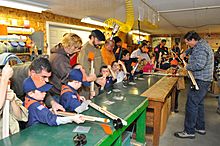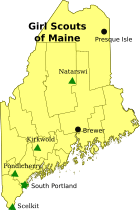Scouting in Maine facts for kids
Quick facts for kids Scouting in Maine |
|||
|---|---|---|---|

Memorial Day parade in Springvale, Maine
|
|||

Cub Scouts make ice fishing lures in Eddington
|
|||
|
|
|||
Scouting in Maine began a long time ago, around 1920, with the creation of the Katahdin Area Council. Since then, Scouting has been a very important part of life for many young people in Maine, continuing strongly to this day.
Boy Scouts of America
How Scouting Started in Maine
Boy Scouting began early in Maine. By 1915, there were already two local Scouting groups. More groups formed in towns like Auburn, Bath, and Saco by 1917. Over the next few years, some groups started, and others joined together or closed down.
By 1922, the Portland group changed its name to Cumberland County Council. This showed that Scouting was growing beyond just the city of Portland. In 1924, the Bangor group also changed its name to Penobscot Council for the same reason.
In 1925, a new group called Pine Tree Council started in Rockland. This group later joined with the Cumberland County Council in 1929. More towns and counties joined the Cumberland County Council, making it even bigger.
By 1930, after many changes and groups joining together, Maine had three main Scouting councils:
- Katahdin Area Council (in Bangor)
- Cumberland County Council (in Portland)
- York County Council (in Saco)
The 1930s brought the final big changes. In 1932, Cumberland County Council became the Pine Tree Council. Then, in 1935, York County Council joined the Pine Tree Council. This left Maine with the two main Scouting councils that are still active today: the Katahdin Area Council and the Pine Tree Council.
Katahdin Area Council
| Katahdin Area Council (#216) | |||
|---|---|---|---|
 |
|||
| Owner | Boy Scouts of America | ||
| Headquarters | Eddington, ME | ||
| Country | United States | ||
| Founded | 1919 | ||
| President | Ken Jarivs | ||
| Scout Executive | Charles Major | ||
|
|
|||
| Website katahdinareabsa.org |
|||
The Katahdin Area Council says it started in 1920. However, the Bangor Council, which was its first name, actually began in 1919. It changed its name to Penobscot Council in 1924, and then to Katahdin Area Council in 1929.
Today, the Katahdin Area Council is huge! It covers about 17,981 square miles (46,571 square kilometers). This makes it the largest Scouting council east of the Mississippi River. It has almost 3,000 adult volunteers and 6,000 young people involved in Scouting. The council's main office is in Orono, Maine.
How the Council is Organized
The Katahdin Area Council is divided into six smaller areas called districts:
- Hancock District
- North Star District
- Penquis District
- Penobscot Valley District
- Waldo District
- Washington District
Scouting Camps
Camp Roosevelt/Katahdin Scout Reservation
| Katahdin Scout Reservation | |||
|---|---|---|---|
| Owner | Katahdin Area Council | ||
| Location | Eddington, Maine | ||
| Country | United States | ||
| Coordinates | 44°46′07″N 68°33′12″W / 44.76863380°N 68.55345540°W | ||
| Founded | 1921 | ||
|
|
|||
Camp Roosevelt, also known as KSR (Katahdin Scout Reservation), is the main summer camp for Scouts BSA in the Katahdin Area Council. It has been open since 1921. The camp is located in Eddington, Maine. It has over 1,800 acres (7.3 square kilometers) of beautiful forest at the base of Black Cap Mountain. A 300-acre (1.2 square kilometer) lake called Fitts Pond is also part of the camp.
The camp has 19 campsites and can host about 500 campers at once. A special part of the camp is the Pamola Lodge, a large log cabin dining hall built in 1929. It is one of the biggest free-standing log cabins in the country.
In 2001, the camp added a COPE program. COPE stands for Challenging Outdoor Personal Experience. It offers fun and challenging activities, both high up and on the ground, for Scouts over 14 years old.
In 2006, the Peter Vigue Scout Center was finished. It has a welcome room and a dining hall that can seat 420 people. The old dining hall was renamed Pamola Lodge in 2009. It is now used for different activities and is being improved for winter use.
Maine High Adventure BSA
Maine High Adventure BSA offers exciting outdoor trips for Scouts from all over the country. It used to be called Maine National High Adventure Area. Hundreds of Scouts and Venturers (older Scouts) enjoy unique trips into the wild areas of northern Maine.
This huge area covers almost 3 million acres (12,000 square kilometers). It includes Mount Katahdin, the Allagash Wilderness Waterway, and parts of the Appalachian Trail. Much of this land is still untouched, just like travelers saw it over 150 years ago.
Since 1970, Maine High Adventure has provided custom trips for youth groups. They offer food, camping gear, transportation, and trained guides. Scouts come from everywhere to experience these amazing outdoor adventures.
Order of the Arrow
| Pamola Lodge 211 | |||
|---|---|---|---|

Pamola Lodge Pocket Flap
|
|||
| Totem | Running Moose | ||
| Founded | 1941 | ||
| Lodge Chief | Devin Plant | ||
| Lodge Adviser | Les Stackpole | ||
| Staff Adviser | Scott Harvey | ||
|
|
|||
Pamola Lodge 211 is the Order of the Arrow group for the Katahdin Area Council. It serves northern and eastern Maine. The Order of the Arrow is Scouting's national honor society. Pamola Lodge covers the largest area of any lodge east of the Mississippi River and is the most northern lodge in the continental United States.
The Lodge officially started in 1941. Its symbol is the Running Moose, which you can see on its patch. The Lodge is named after Pamola, a legendary spirit from Mount Katahdin in Penobscot Indian stories.
In 2006, Pamola Lodge won the National Service Award for its excellent service to its council. In 2015, it also won an award for its ceremonies.
Pine Tree Council
| Pine Tree Council | |||
|---|---|---|---|
 |
|||
| Owner | Boy Scouts of America | ||
| Headquarters | Raymond, ME | ||
| Country | United States | ||
| Founded | 1919 | ||
| President | Jack O'Toole | ||
| Council Commissioner | Mike L'Abbe | ||
| Scout Executive | Matthew Klutzaritz | ||
|
|
|||
The Pine Tree Council (#218) started in 1919 as the Portland Council. It grew and changed names several times, eventually becoming the Pine Tree Council we know today in 1933. Other councils, like the original Pine Tree Council (#710) and York County Council, joined it over the years.
Scouting in the Community
Scouts in Maine have always been very active, with strong support from their communities. For example, in 1953, 39 Scouts from Maine traveled to the National Scout Jamboree. They were part of a special group called Troop 27.
Council Districts
The Pine Tree Council has four districts:
- Abnaki District
- Casco Bay District
- Kennebec Valley District
- York District
Scouting Camps
Camp Bomazeen
Camp Bomazeen is located on Great Pond in North Belgrade, Maine. This pond was the inspiration for the famous movie "On Golden Pond." Camp Bomazeen opened in 1946. For 57 years, it was a summer camp for Boy Scouts, offering many special programs like wilderness survival and photography.
After 2003, the camp stopped being a full-time summer camp. Now, Bomazeen is used all year round by different Scout groups for weekend trips and events. It's also a great place for new Cub Scouts and their parents to learn about Scouting. Training courses for adult leaders are also held here.
The Pine Tree Council is working to raise money to improve the camp's facilities. Boy Scout summer camp is planned to return to Camp Bomazeen in 2014.
Camp Bomazeen is named after Chief Bomazeen, a leader of the Norridgewock tribe. The land for the camp was given as a gift in 1944.
Camp Gustin
Camp Gustin is located on Loon Pond in Sabattus, Maine. This camp has been used for Scouting events since at least 1947. It's a popular spot for the Abnaki district, hosting many events like Cub Scout day camps.
The camp has open fields and wooded areas for camping. It also has clean water, restrooms, a pond, and a pavilion. Scouts use Camp Gustin for training, hiking, and family camping. It's a great place for outdoor adventures.
For a while, the council thought about selling Camp Gustin. But in 2010, they decided to keep it as a place for all Scout groups to enjoy outdoor programs.
Camp William Hinds
| Camp William Hinds | |||
|---|---|---|---|
| Owner | Pine Tree Council | ||
| Location | Raymond, Maine | ||
| Country | United States | ||
| Coordinates | 43°56′58″N 70°28′10″W / 43.94934°N 70.46936°W | ||
| Founded | 1927 | ||
|
|
|||
Camp William Hinds opened in 1927. It was the summer camp for the Cumberland County Council. The camp is named after the son of the person who donated the land. It covers 230 acres (0.93 square kilometers) on Panther Pond in Raymond, Maine. It is currently the only main long-term camp for the Pine Tree Council.
Scouts at Camp Hinds enjoy a full week of summer programs. These include swimming, nature studies, outdoor skills, archery, and climbing. The Ring Dining Hall is where everyone eats and enjoys evening programs. The camp also has popular winter programs during school breaks.
The camp has 14 large campsites and three cabins available all year. Summer camp includes seven weeks for Scouts BSA and two shorter sessions for Webelos Cub Scouts. There are also "Summer Fun Pack Weekends" for Cub Scout families.
Camp Hinds has been used a lot over the years. In 1954, it hosted a training event for 2,000 adult volunteers. The camp's Trading Post used to sell many plastic neckerchief slides made by C. Millard Neal, a volunteer. These slides were very popular across the country.
Camp Nutter
Camp William Nutter is located on Loon Pond in Acton, Maine. It was originally the summer camp for the York County Council. When that council joined the Pine Tree Council in 1935, Camp Nutter was not used as a summer camp for a while.
However, it reopened as a summer camp sometime after 1944 and operated into the 1950s. The council still owns the property today. It is mainly used by the York District for weekend events and Cub Scout Day Camp.
Order of the Arrow
Madockawanda Lodge 271 is the Order of the Arrow Lodge for the Pine Tree Council. It serves Scouts in central and southern Maine. This Lodge has been active since it started in 1944 at Camp Hinds.
Frank W.P. Bailey, a long-time staff member at Camp Hinds, founded Madockawanda Lodge. He named it after the great Native American Chief Madockawando, who united the Penobscot Nation. The Lodge's symbol is the snapping turtle.
In its early years, the Lodge had smaller groups (chapters) at the council's summer camps. As time went on, elections for the Order of the Arrow moved to local Scout units.
Madockawanda Lodge has received many awards. It has won the National Service Award four times, more than any other lodge in its region. It has also been recognized as a "quality lodge" many times since 1991.
Girl Scouts of the USA
Girl Scouts of Maine
| Girl Scouts of Maine | |||
|---|---|---|---|

Map of Girl Scout Councils in Maine
|
|||
| Headquarters | South Portland, Maine | ||
| Country | United States | ||
|
|
|||
| Website girlscoutsofmaine.org |
|||
The only Girl Scout council in Maine is called Girl Scouts of Maine. It was formed in October 2007 when two older councils, Abnaki Girl Scout Council and Girl Scouts of Kennebec Council, joined together.
This council serves over 14,000 girls and has about 4,000 adult volunteers. Its main office is in South Portland, Maine.
History of Girl Scouts in Maine
The first known Girl Scout troop in Maine started in Portland in 1912. The Abnaki Girl Scout Council was created in northern Maine in 1962. It brought together several smaller councils and many individual troops. The Girl Scouts of Kennebec Council was formed in 1963 from 11 southern Maine councils and other troops.
How the Council is Organized
Girl Scouts of Maine has several service centers to help its members:
Girl Scout Camps
Girl Scouts of Maine operates several camps:
- Kirkwold is in Readfield.
- Natarswi is in Baxter State Park near Millinocket.
- Pondicherry is a 700-acre (2.8 square kilometer) camp in the White Mountains near Bridgton.
- Scelkit is a 5-acre (20,000 square meter) camp on Gerrish Island, Kittery Point.
See also
- Neal Manufacturing Company
- Scouting in New Brunswick
- Scouting in Québec
- Scouting in New Hampshire

